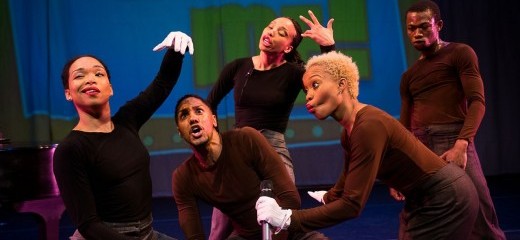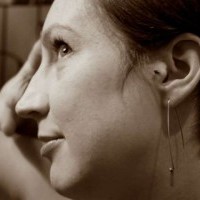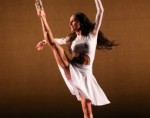
Photo: Christopher Duggan
One Brave Black Girl
by Becca Weber
BRAVE.
The word, all caps, I wrote in my notes about The Dialogue, the closing “act” to Camille A. Brown & Dancers’ performance, featuring Black Girl: Linguistic Play (a work-in-progress), Mr. TOL E. RAncE, and New Second Line.
Why brave? Audience talk-backs are common--a necessary skill for today’s touring artists. But something in the structure--naming it as the fourth piece, perhaps; or the quickness with which she arrived, mic in hand; or maybe the directive to stay we were given at the start and close of the concert--asked more of Brown. It opened up her work and her goals, and made them more vulnerable than the usually polite Q&A format. The Dialogue began with reflections from audience members--feedback for Brown--and then grew into a back-and-forth between attendees, Brown, and her dancers about their experiences watching the performance.
The show, chock-a-block with dynamic dancing, layered physical textures and honest content surrounding the experiences of being black in the United States. It provided both high-art concert dance and political activism. Brown’s company, identified in the program as the “Entertainers,” demonstrated a wide range of technical prowess. For instance, Mr. TOL E. RAncE felt like a diasporic history lesson, with elements in the choreography pulled from African dance, tap, swing, double-dutch, step, soft shoe, hip hop, social dances like the “roger rabbit”--and vernaculars not always associated with the diaspora: ballet, Horton, and release technique. The piece, set to live compositions played by Scott Patterson on a grand piano stage right, opened with early footage of cake walks and minstrelsy. It jumped from close-quarters “juke joint” dance-offs to an energetic sing-along to the theme of The Fresh Prince of Bel-Air. It circled back to a solo that seemed to be inspired by a Ring shout, a dancer with feet shuffling and palms waving skyward. The work cavorted back and forth in time, showcasing lineage and raising audiences’ awareness of shared movement vocabulary in the diaspora through the ages. The dancing was energetic, feverish, and frenzied--contagious, too; I saw viewers continuing to groove in the aisles and enclaves during the following intermission.
Black Girl, an all-female piece accompanied by both the pianist and a bass guitarist, begins with a striking solo by Brown. In street wear, she steps onto a raised platform. Her sneakered heel taps; it reverberates through her body. Repeats. She taps and twists internally, right, left, right, left. Side to side, snap. Body roll. Tap, tap, then a gesture--she looks into an invisible hand-held mirror. A quickening, a running--faster, faster, and faster. Then a fizzling out, a pause. Brown, hunched over, breathing hard: her solo, as rhythmic as Mr. TOL E. RAncE, but more subdued.
Her subtle energy invites closer inspection. I am in awe, in both works, of Brown’s impeccable timing, of how her use of those moments of stillness, silence, and pause give me the opportunity to reflect.
Later, in
The Dialogue, she admitted to anger. She says the skullcap she wore in this solo evoked a sense of masculinity, which engaged her feelings surrounding the
current events our nation
is grappling with. Her anger in the running, and her fatigue thereafter were real. She declared, “Black women are pigeonholed into two tropes--the angry black woman and the strong black woman.” But in
Black Girl, Brown exposed more facets: the full spectrum of the black female experience. In the dialogue, audience members echoed her sentiments. Said one, “For me, that was my life on stage...I was watching where I’ve been.” Another said, “That was also
my life on stage...the FATIGUE of being a black woman in America.” Brown’s dancers, too, spoke about examining their own experiences--whether fulfilling the stereotypes of black women to protect themselves from street harassment or, as dancer Fana Fraser stated, the “hybrid identities within myself.” Though she is Trinidadian, Fraser noted, “In America, I am black.”
This is why it was so brave. Not only was Brown opening up her work for anybody’s interpretation and critique, she was opening up her life--all the layers of identity therein--and all of the complications our society puts upon those lives. She was proving, to all in attendance, that #blacklivesmatter.
Camille A. Brown & Dancers, Goodhart Hall, Bryn Mawr College, December 5.
Note: Several thINKing DANCE members attended this performance as part of a writing workshop led by Elizabeth Zimmer. You can read
Nicole Bindler's review here.
By Becca Weber
December 11, 2014







.png)


